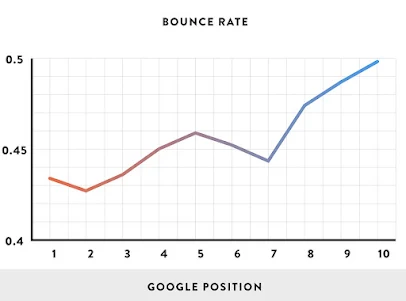**Bounce rate** is a metric that measures the percentage of visitors who leave a website after viewing only one page, without engaging further or navigating to other pages. While bounce rate is not a direct ranking factor in Google’s algorithm, it can still have significant implications for SEO and overall website performance. Here’s how bounce rate affects SEO:
### 1. **User Engagement and Experience**
- **Indicator of Content Quality:** A high bounce rate may suggest that users aren’t finding the content relevant or engaging. If visitors quickly leave after viewing a single page, it may signal to search engines that the content isn’t meeting user expectations.
- **Impact on Dwell Time:** Bounce rate can indirectly affect dwell time (the amount of time a user spends on a page before returning to search results). A low bounce rate typically indicates that users are spending more time on your site, which can be a positive signal to search engines.
### 2. **SEO Performance Signals**
- **Behavioral Signals:** Search engines use various user behavior metrics, including bounce rate, as signals of content quality. A high bounce rate could negatively influence your site's perceived quality, which may impact rankings.
- **Algorithm Updates:** While bounce rate itself may not be a direct ranking factor, Google’s algorithms are designed to prioritize user satisfaction. If a high bounce rate correlates with low user satisfaction, it can indirectly lead to lower rankings.
### 3. **Impact on Conversion Rates**
- **Lead Generation and Sales:** High bounce rates can negatively affect conversion rates, as fewer visitors are engaging with your content or taking desired actions (like signing up for newsletters, making purchases, etc.). This can hurt your overall business goals, even if SEO rankings remain stable.
- **Identifying Problem Areas:** A high bounce rate can highlight pages that may need improvement. Analyzing which pages have high bounce rates can help you identify areas for optimization, such as content relevance, design, or call-to-action effectiveness.
### 4. **Context Matters**
- **Type of Content:** Different types of pages naturally have varying bounce rates. For example, a blog post may have a higher bounce rate if users find the information they need and leave, while an e-commerce site may aim for lower bounce rates to encourage further exploration.
- **Intent and User Behavior:** Understanding the context of user intent is essential. If a visitor finds the answer they’re looking for on a single page (e.g., FAQs or a specific article), a bounce may not indicate a negative experience.
### 5. **Using Bounce Rate as a Diagnostic Tool**
- **Performance Monitoring:** Regularly monitor bounce rates across different pages and traffic sources to gain insights into user behavior and identify potential issues.
- **Testing and Optimization:** Use A/B testing to experiment with different page layouts, calls to action, or content types to reduce bounce rates and improve user engagement.
### Strategies to Reduce Bounce Rate and Improve Engagement
1. **Improve Content Quality:**
- Ensure that your content is relevant, informative, and engaging to keep users on the page longer.
2. **Enhance User Experience:**
- Optimize site design, load speed, and mobile-friendliness to provide a better user experience.
3. **Use Clear Navigation:**
- Make it easy for users to find what they’re looking for by using clear menus and internal linking.
4. **Include Relevant Internal Links:**
- Encourage users to explore more content on your site by linking to related articles or products within your content.
5. **Create Compelling Calls to Action:**
- Use persuasive CTAs that encourage users to take the next step, whether it’s reading more articles, signing up for a newsletter, or making a purchase.
6. **Segment Traffic Sources:**
- Analyze bounce rates by traffic source (e.g., organic, social, referral) to identify which channels may need different strategies.
### Conclusion
While bounce rate itself may not be a direct ranking factor in SEO, it serves as an important indicator of user engagement and content quality. A high bounce rate can suggest that users are not finding what they need, which can ultimately affect your site's SEO performance. By monitoring bounce rates and implementing strategies to improve user experience and engagement, you can positively influence both your SEO and conversion rates.









0 Comments